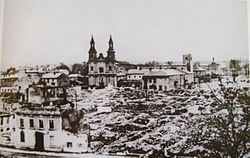Date 1 September 1939 | Location Wieluń, Poland | |
 | ||
Similar World War II, Bombing of Duisburg in World Wa, Bombing of Bangkok in World Wa, Bombing of Bremen in World Wa, Bombing of Vienna in World Wa | ||
The bombing of Wieluń refers to air raids on the Polish town of Wieluń by the German Luftwaffe on 1 September 1939. The Luftwaffe started bombing Wieluń at 04:40, five minutes before the shelling of Westerplatte, which has traditionally been considered the beginning of World War II. The air raid on the town was one of the first aerial bombings of the war. It killed an estimated 1,300 civilians, injured hundreds more and destroyed 90 per cent of the town centre The casualty rate was more than twice as high as Guernica. After the bombing Nazi propaganda claimed that there was a cavalry unit in the city, although in reality no military units were stationed
Events
According to German military records, 29 Junkers Ju 87B “Stukas” of Sturzkampfgeschwader 76 under the command of Captain Walter Sigel, started from Nieder-Ellguth airfield at 05:02 on 1 September 1939. Some twenty minutes later they reached the town of Wieluń unopposed and dropped 29 bombs of 500 kg and 112 bombs of 50 kg. Among the first places hit was the hospital, though it had Red Cross markings; 26 patients and 6 nurses were killed. Within the hour all 29 aircraft landed at Nieder-Ellguth, where Sigel reported "no noteworthy observation of the enemy." The German pilots reported "blue sky" when attacking the town and described in detail buildings bombed.
A second wave of 29 Stukas of Sturzkampfgeschwader 2 Immelmann commanded by Major Oskar Dinort attacked the town shortly afterwards, followed by a third wave at about 14:00. In all, 380 bombs totalling 46,000 kg had been dropped on the town, hitting the hospital, killing more than 1,200 inhabitants and destroying 70 per cent of the buildings, up to 90 per cent in the center. According to German documents the town was burning at 06:00 – "Wielun brennt" - Wieluń is burning.
Writer Sylwia Słomińska and Sender Freies Berlin director Joachim Trenkner (author of German 1989 TV documentary about the bombing of Wieluń) stated in the documentary that there were no military or industrial targets in the area, except for a small sugar factory in the outskirts of the town. Furthermore, Trenkner stated that German bombers destroyed the town's hospital first.
German historian Horst Boog claims that a Polish cavalry brigade and a Polish infantry division had been located in the town by German reconnaissance the day before the attack. From reports of Luftflotte 4, 2nd Air Division, I./Sturzkampfgeschwader 76 and I./Sturzkampfgeschwader 77 he concludes that the bomb attacks had been directed against these military formations and therefore can not be considered terror bombings. Due to ground fog, he argues, the German pilots missed their targets and mistakenly bombed the town. In separate accounts by both German pilots and Polish civilians, Polish civilians report planes clearly visible, while German pilots distinguish civilian targets while bombing from up to 2500 meters British aviation historian Peter C. Smith too, describes the bombing as collateral damage from bombs that missed their targets during ground support of the Wehrmacht operations. Polish historian Jerzy B. Cynk, author of The Polish Air Force at War. The Official History 1939-1943, is believed to have also written about these events. The visibility allowed German pilots to engage in strafing runs against fleeing civilians,including women and children, systematically massacring them with repeated machine gun fire.
At 13:00 a German dive bomber wing, I./StG 2 led by Major Oskar Dinort via Nieder-Ellguth, were directed against Wielun, followed a few hours later by Günter Schwartzkopff with sixty Ju 87 Stukas of I./Sturzkampfgeschwader 77 Weather conditions were unfavourable during the day, with a visibility of only one kilometre and a practically closed layer of fog at 50 metres altitude. Fog, mist and poor visibility thwarted many of the Luftwaffe's sorties planned for the morning of the first day of the invasion. The dive bombers, facing intense anti aircraft fire, inflicted heavy losses on the Polish cavalry, and the advance was turned into a rout by 90 Stukas. On their return home, four of the German Junkers Ju 87 bombers were shot down by the Polish 36 Academic Legion Infantry Regiment stationed nearby. Three waves of attacks were carried out during the day. The town was captured by the German Army on the first day of the invasion.
Two attempts to persecute the attack on the hospital were dealt with shortly by West German judges in 1978 and 1983, since prosecutors emphatically claimed that the pilots could not make out the nature of the target in alleged morning fog
